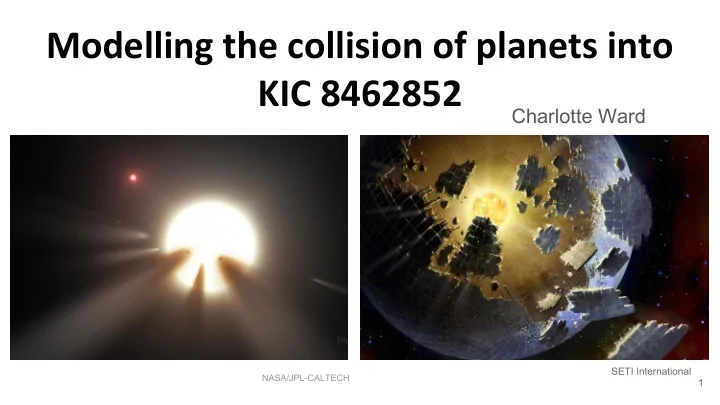

Modelling the collision of planets into KIC 8462852 Charlotte Ward SETI International NASA/JPL-CALTECH 1
KIC 846282 showed unusual flux dips in Kepler data ● KIC846282 is a typical F3 main sequence star with no interacting companions. ● Short dips in up to 22% of flux were observed on [1] timescales of days. ● 3% dimming over the 4.25 years of Kepler data were observed. ● Photographic plates showed 14% dimming since 1890. [2] [3] 2
The dimming may be caused by planet consumption ● Transfer of the kinetic energy of the inspiralled body to the outer layers of the star causes an increase in flux (Metzger et al 2017). ● Kepler observed the subsequent dimming. ● To explain 4 year and 100 year dimming, Earth mass and subsequent moon mass consumption must be invoked. 3
Project goals ● Replicate the mesa star modelling results of Metzger et al 2017 to show effects of different planetary bodies on star flux. ● Test the Earth and moon collision scenario. ● Investigate short time scale variability of the star and its sensitivity to assumptions in Metzger et al 2017. Elizabeth Landau, 2017, NASA 4
Inspiral energy is deposited to outer layers of the star ● Deposited energy as a function of radius for inspiralling body is given by: ● Density vs radius of the star is obtained by modelling a 1.43 solar mass star on the main sequence with Mesa (Paxton 2011). ● Energy deposited vs radius calculated for Io, Earth and Jupiter mass planets. ● Extra module in mesa developed to add inspiral energy to star cells over time. 5
Star experiences a rise and slow decay in luminosity ● Results from Metzger et al 2017 showing rise and decay in luminosity were replicated. ● An Io collision could produce the 4 year dimming. ● An Earth collision could produce the 100 year dimming. 6
Earth followed by Io collision explains observations ● Metzger et al 2017 suggest than an Earth mass collision was followed by collision with its moon a few orbits later. ● This would explain 4 and 100 year dimming. ● Simulations showed that Io collision produced a dip in flux before brightening. 7
Planet inspiral causes extreme short term variability ● Simulations suggest 3 order of magnitude increases in luminosity for Jupiter, 50% increase in luminosity for Io. ● Have such increases in luminosity been observed? 8
Timescale over which energy is deposited affects short term brightness ● The short term luminosity is dependent on energy deposition time. ● After 0.5 days the different simulations converge. Earth Io 9
Deposition may occur over ~1 day ● If we consider that energy loss occurs as the planet transfers energy to particles in the star according to ● We find for inspiral speed: ● It takes 12000 seconds for the planet to reach the tidal disruption radius 10
Summary ● Metzger et al 2017 simulation results were replicated for inspiralling planetary bodies. ● Earth followed by Io mass collision model suggested by Metzger et al was confirmed to be feasible. ● Short term variability was shown to be sensitive to deposition timescales. Longer timescales are proposed. ● Dips in flux were shown to arise from Io masses. 11
Recommend
More recommend